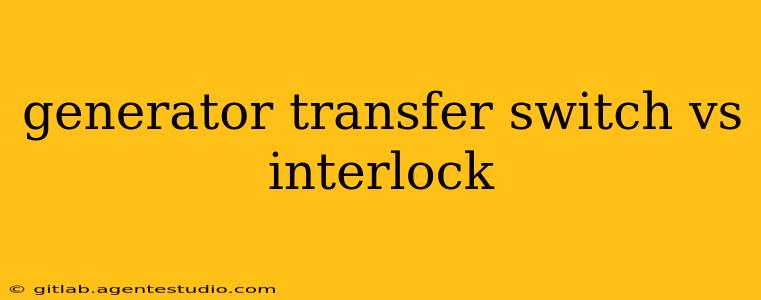Power outages are a frustrating reality for many homeowners. While a home generator can provide a crucial lifeline during these disruptions, the method you use to connect it to your home's electrical system is critical. This article compares two common approaches: generator transfer switches and interlocks. We'll explore their functionalities, safety features, and help you determine which option best suits your needs and budget.
Understanding Generator Transfer Switches
A generator transfer switch is a sophisticated device that acts as a central control point for directing power. It automatically (or manually, depending on the model) disconnects your home from the utility grid and seamlessly transfers power to your home's circuits from your generator. This ensures that only the circuits you've selected receive power from the generator, preventing backfeeding, which poses a serious risk to utility workers and can damage your generator.
Advantages of Generator Transfer Switches:
- Safety: The primary advantage is its inherent safety. By completely isolating your home's wiring from the utility grid, it eliminates the risk of backfeeding.
- Convenience: Automatic transfer switches offer seamless transitions, instantly switching power sources when the grid fails.
- Efficiency: You only power the circuits you need, conserving fuel and extending your generator's lifespan.
- Code Compliance: Most building codes require transfer switches for larger generators or for supplying essential circuits.
Types of Generator Transfer Switches:
- Automatic Transfer Switches (ATS): These automatically switch power when the utility power fails.
- Manual Transfer Switches (MTS): These require manual switching, offering a lower-cost alternative.
Understanding Interlocks
A generator interlock is a simpler, and often less expensive, system. It's essentially a mechanical device that prevents both the main breaker and the generator breaker from being on simultaneously. It relies on a physical lock mechanism to prohibit the user from accidentally connecting the generator to the home's electrical system while it's still connected to the utility grid.
Advantages of Generator Interlocks:
- Cost-Effectiveness: Interlocks are generally less expensive than transfer switches.
- Simplicity: Installation is typically easier and faster.
Disadvantages of Generator Interlocks:
- Safety Concerns: Interlocks offer significantly less safety than transfer switches. They prevent backfeeding, but rely on user adherence and may not work if tampered with.
- Inconvenience: Manual switching is required, interrupting power temporarily during the transition.
- Limited Functionality: Only allow for a limited number of circuits to be powered, significantly limiting the utility of your generator.
- Not Code Compliant: Many building codes explicitly prohibit or discourage the use of interlocks for home generator installations.
Generator Transfer Switch vs. Interlock: A Direct Comparison
| Feature | Generator Transfer Switch | Generator Interlock |
|---|---|---|
| Safety | High (Complete isolation from utility grid) | Low (Relies on user adherence and prevention) |
| Cost | Higher | Lower |
| Convenience | High (Automatic switching available) | Low (Manual switching required) |
| Functionality | High (Can power multiple circuits) | Low (Limited number of circuits) |
| Code Compliance | Typically required for larger installations | Often prohibited or discouraged |
Making the Right Choice
For most homeowners seeking reliable backup power, a generator transfer switch is the clear winner. While the upfront cost is higher, the enhanced safety, convenience, and compliance with building codes far outweigh the cost savings of an interlock. The potential risks associated with backfeeding and the inconvenience of an interlock make it a less desirable option for most home generator installations.
Remember to consult with a qualified electrician to determine the best solution for your specific needs and ensure a safe and compliant installation. They can assess your home's electrical system and recommend the appropriate transfer switch or other power backup solutions.

